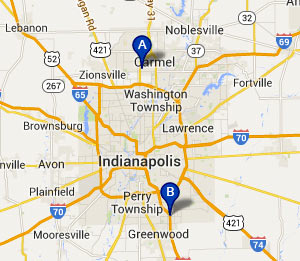Blepharitis
Eyelid Margin Inflammation
What is Blepharitis and Eyelid Margin Disease?
Blepharitis is a very common chronic inflammatory condition of the eyelid margin. Eyelid margin disease (blepharitis) is associated with aging but may occur at any age. Blepharitis may have an anterior and/or posterior component. Anterior Eyelid Margin Disease refers to crusting on the eyelashes due to a superficial infection and associated inflammation caused by a variety of micro-organisms. Posterior Eyelid Margin Disease is dysfunction of the oil glands near the base of the eyelashes resulting in an unstable tear film and dry, irritated, red eyes.
What causes Blepharitis?
Anterior Blepharitis is most commonly associated with a bacterial infection (Staphylococcus, Proprionibacterium) or less commonly a parasitic infestation (Demodex folliculorum). Posterior Blepharitis results from meibomian (oil) gland dysfunction (MGD). Obstructive meibomian gland disease is the most common manifestation of oil gland dysfunction. Less often a hypersecretory condition, usually seen with skin disorders such as rosacea, eczema, or seborrheic dermatitis, is the underlying problem. Without delivery of normal meibomian gland secretions to the tear film, the tears become unstable resulting in dry, irritated, and inflamed eyes.
What are the Most Common Symptoms?
Excessive matter and crusting on the eyelids upon awakening; a gritty feeling in the eyes; a burning sensation that is worse while reading, driving, watching T.V., or working at the computer. Individuals with blepharitis may also experience itchy, red, irritated or swollen eyelids typically worse in the morning. Patients with blepharitis will often have symptoms of Dry Eyes. Dry eye patients tend to notice worsening of their symptoms later in the day, whereas blepharitis symptoms are typically worse early in the day. As with dry eye disease, patients with blepharitis may have difficulty tolerating contact lens wear. More severe cases of blepharitis may result in misdirected eyelashes (trichiasis), loss of eyelashes (madarosis) and scarring or irregularity of the eyelid margin (tylosis).
How is Blepharitis Treated?
 Watch to learn more about the treatment of Blepharitis
Watch to learn more about the treatment of Blepharitis
Blepharitis is a chronic problem that may come and go throughout one’s life. Some form of treatment may be required from time to time to adequately control the symptoms associated with blepharitis. Inadequate treatment may lead to irreversible changes in the meibomian glands. Eyelid hygiene is essential and the most effective long-term treatment of blepharitis. Eyelid hygiene techniques are outlined below and include daily warm compresses, lid margin scrubs, and lid massages. Like brushing your teeth, regular eyelid hygiene practices are important in the treatment of blepharitis. Oral omega-3 dietary supplementation for 12 months has been shown to be helpful the treatment of both dry eyes and blepharitis.
Short-term use of topical antibiotics, combined with eyelid hygiene, may be helpful in some clinical situations. Azithromycin 1% has both anti-bacterial and anti-inflammatory properties and may improve meibomian gland function and the symptoms associated with blepharitis. Oral antibiotics, such as doxycycline, may be indicated in cases of severe blepharitis due to ocular rosacea. Short-term use of mild, topical corticosteroids may be helpful when significant eyelid margin inflammation is present. Dry Eye management is also a critical component of blepharitis management. Newer lubricant eye drops, such as Systane Balance (Alcon Laboratories), are being developed to treat dry eyes caused by meibomian gland dysfunction.
Warm Compresses
The purpose of warm compresses is to open up the pores at the ends of the ducts where the glands drain onto the margins of the eyelids and ultimately into the eye. Warm compresses are warm or hot soaks placed over the closed eyelids.
A good way to perform at least one of your hot compresses each day is to do so while in the shower. Turn the water temperature up a few degrees, place a face cloth across your eyes, turn your face toward the water stream, and allow your face and eyelids to soak in the warm water for five minutes or so (perhaps while you have conditioner soaking in your hair). Hot compresses should also be applied upon awakening and prior to going to bed. A dampened face cloth should be placed across the eyes for five to ten minutes. The face cloth may need to be reheated with hot tap water after four or five minutes. Some individuals like to heat a dampened face cloth in the microwave. This may help retain the heat within the cloth; however this must be done with extreme caution so as not to overheat the cloth and burn the skin. Be careful not to burn yourself with the hot compresses. Remember, the compresses should be warm to hot and NOT scalding. Always carefully check the temperature of the compress prior to applying the compress to the face.
Eyelid Margin Scrubs
The purpose of eyelid margin scrubs is to clean the eyelashes and eyelid margin and to mechanically remove many of the micro-organisms that are growing on the edge of the eyelid.
Dilute Baby Shampoo should be placed on a warm, damp wash cloth. The eyelashes and eyelid margin should be scrubbed with a back and forth motion with the eyes closed. Baby shampoo or other mild soap solution is recommended in order to minimize eye irritation. This may be performed while in the shower or just prior to bedtime.
Eyelid scrub pads or towelletes are also available for purchase in most convenience and grocery stores.
Eyelid Massages
The purpose of lid massages is to massage the thick and irritating oils out of the eyelid and into the tear film. For the patients with adequate manual dexterity, lid massages should be performed directly following hot compresses. With the eyelids closed, the upper eyelids are massaged downward and the lower eyelids are massaged upward.
Summary
Blepharitis is a common, frequently unrecognized condition. The symptoms may vary from mild irritation to severe inflammation and visual complications. Eyelid hygiene traditionally has been the hallmark of long-term therapy. Current research is being directed to treatments that address the underlying causes of blepharitis and meibomian gland dysfunction.
Dry Eyes
Our tears have both an aqueous (water) and lipid component. If either component is deficient, then rapid tear evaporation and discomfort due to dry eyes may result. Patients with dry eyes typically experience a "gritty" or "sandy" feeling that is worsened by cold and/or windy environments. Many patients with dry eyes will actually experience increased eye watering, referred to as reflex tearing, since feedback from the eye to the brain may result in increased tear secretion from the lacrimal gland (large tear forming gland under the outside aspect of the upper eyelid). In these cases, patients have intermittent, excessive tearing with underlying chronic eye irritation.
